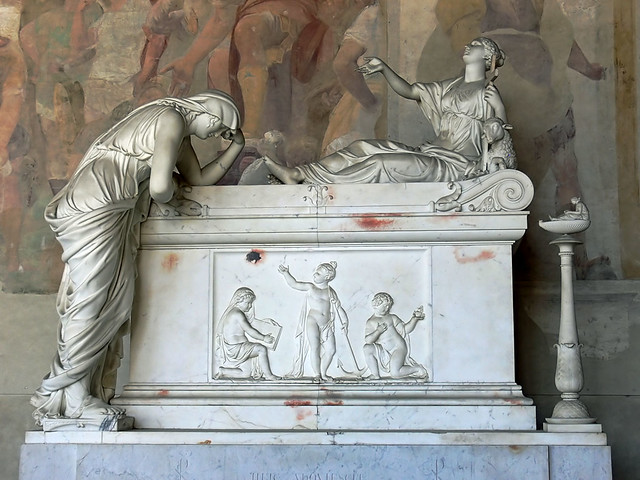Tomb of Anastasia Petri-Schouvaloff - Camposanto Monumentale Pisa

This elegant Neoclassical funeral monument, located in the portico of the Camposanto Monumentale within Pisa's Piazza dei Miracoli UNESCO World Heritage site, commemorates Anastasia Petri-Schouvaloff (dates uncertain, likely 18th–19th century). Crafted from white Carrara marble, the tomb is attributed to an artist of the neoclassical school, possibly influenced by Lorenzo Bartolini or Antonio Canova, and dates to the early 19th century (circa 1820s–1830s). It reflects the period's blend of classical idealism and Romantic sentimentality, set against the backdrop of the cemetery's faded frescoes (e.g., remnants of Buonamico Buffalmacco's Triumph of Death). The monument honors Anastasia, likely a member of the noble Schouvaloff (Shuvalov) family, a prominent Russian lineage with ties to European aristocracy, possibly linked to Pisa through marriage or exile.
The monument embodies the neoclassical revival in Tuscany, influenced by the Grand Tour and the Shuvalov family's European connections, possibly reflecting Anastasia's Russian-Italian heritage. The emotional interplay between the mourner and the reclining figure aligns with Romantic themes of loss, while the genii evoke classical mythology. The Camposanto's relocation of such tombs during 19th-century restorations highlights its role as a repository of Pisan and cosmopolitan heritage.
The tomb is a rectangular sarcophagus, approximately 2.5 meters long and 1.5 meters high, elevated on a stepped marble plinth. Its lid features curved volute (scroll) motifs at the corners, echoing ancient Roman designs, while the front face is adorned with a low-relief panel. A tall, fluted candelabrum or votive stand to the right adds a ceremonial touch, its ornate base complementing the sarcophagus's classical lines. The marble shows reddish-brown discoloration, likely from weathering or the 1944 bombing damage to the Camposanto, lending a historical patina.
Atop the sarcophagus lies a life-sized recumbent female figure, representing Anastasia or an allegorical personification (e.g., the soul or a virtue like Hope). She reclines on her left side, propped on one elbow, with her head tilted back and right arm raised in a gesture of offering or ascension. Her flowing drapery, carved with delicate folds, clings to her form, revealing a classical nude torso partially veiled in the style of Canova's Psyche Revived. Her expression is serene, with closed eyes and a gentle smile, suggesting peaceful repose or eternal rest. Her bare feet extend toward the edge, sculpted with natural detail, enhancing the figure's lifelike quality.
To the left, a standing female figure (about 1.2 meters tall) embodies grief or devotion, bending forward with her head resting on her right hand in a mourning pose. Her left arm supports her weight on the sarcophagus edge, and her long, flowing robe with intricate pleats cascades to the ground. The veiled headdress and slumped shoulders convey deep sorrow, contrasting with the reclining figure's tranquility. This mourner likely represents a family member or an allegorical figure like Piety, adding a personal narrative to the monument's classical framework.
The front face features a shallow relief panel with three winged genii (putti), symbolizing the soul's journey or virtues. The left genie kneels, holding an open book (wisdom or scripture). The central genie stands, holding a staff and raising a small object (possibly a flower or flame), signifying life or eternity. The right genie kneels, offering a butterfly (the soul's ascent). These childlike figures, carved with soft features and dynamic poses, reflect neoclassical grace and symmetry. The relief is framed by a simple molding, with reddish stains adding an unintended, somber accent that ties into the cemetery's historical context.
